What is zeta potential and how does TRPS measure it?
TRPS has the unique feature to measure particle zeta potential and size simultaneously on a particle by particle basis. A particle’s zeta potential is related to its surface charge and is defined as the potential difference between dispersion medium and the stationary layer of fluid attached to the dispersed particles. From a theoretic point of view, it is the electrical potential at the slip plane of the interfacial double layer. Zeta potential is often used as an indicator for colloidal stability. For charge stabilised particles, zeta potential values of |30 mV| or higher are representative of a stable colloidal system. Also, a particle’s zeta potential is useful in identifying biological analytes carrying different surface charge when their sizes are comparable.
In order to achieve accurate and reliable particle zeta potential measurements by TRPS, instrument settings should ensure that the electrophoretic forces are the dominant contribution to particle transport mechanism. For this reason, the pressure range applied during zeta potential measurements should be minimal, typically no more than 100 Pa.
Like in other technologies, the electrophoretic mobility (μ) is measured as a way to calculate the particle zeta potential in aqueous media and moderate electrolyte concentrations. The electrophoretic mobility relates to the velocity of particles in a unit of electric field. The particle zeta potential (ζ) is typically related to the electrophoretic mobility by the Smoluchwski approach:
![]()
where η and ε are respectively dynamic viscosity of the electrolyte and dielectric constant.
Robust and reproducible single particle zeta potential measurements can be achieved by recording the translocation duration of nanoparticles as a function of both voltage and pressure. This calibration-based, convection-inclusive, zeta potential methodology involves the use of the proportional blockade magnitude as a measure of particle position within the pore. For example, with reference to the graphic below, T1.0 is the time the blockade is at 100% maximum value, while T0.4 is the time at which the resistive pulse signal reaches 40% blockade maximum, with respective positions within the pore being L1.0 and L0.4. Differential electrokinetic mobility and convection can be determined from the 1/T vs voltage and 1/T vs pressure curves of a calibrant respectively.

Due to the linear relationship of electrokinetic (electroosmotic and electrophoretic) particle velocities of sample and calibration and respective zeta potentials, based on the Smoluchowski approximation, single particle zeta potentials can be calculated. A detailed guide of the derivation of single particle zeta potential can be found in [1,2].
Please note that zeta potential evaluations are done at various positions within pore rather than just the end of sensing zone. This guarantees effective quality control and elimination of rogue events such as electronic noise spikes.
References:
1. VOGEL, R., PAL, A. K., JAMBHRUNKAR, S., PATEL, P., THAKUR, S. S., REÁTEGUI, E., PAREKH, H. S., SAÁ, P., STASSINOPOULOS, A. & BROOM, M. F. 2017. High-Resolution Single Particle Zeta Potential Characterisation of Biological Nanoparticles using Tunable Resistive Pulse Sensing. Scientific reports, 7, 17479.
2. BLUNDELL, E. L. C. J., VOGEL, R. & PLATT, M. 2016c. Particle-by-particle charge analysis of DNA-modified nanoparticles using tunable resistive pulse sensing. Langmuir, 32, 1082-1090.